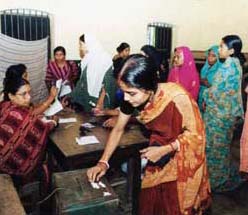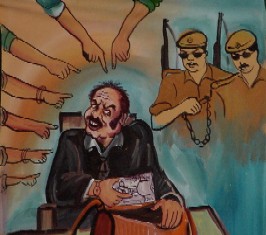 |
 About Bangladesh |
 |
| Population & Health | Democracy & Governance | Anti-Trafficking | Enterprise Development | Energy |
| Environment | Food Security | Disaster Management | Education | Gender |
Facts About the Country
Flag:

Official Name:
People's Republic of Bangladesh
Capital:
Dhaka
Ethnicity:
Bengali 98%; tribal groups and non-Bengali Muslims 2%
Population:
Approximately 140 million*
Population Growth Rate:
1.9%*
Life Expectancy:
63.5 years (male and female)*
Religions:
Muslim 88%; Hindu 11%; Christian, Buddhist, others 1%
Official Language:
Bengali
Year of Independence:
1971 (from Pakistan)
Type of Government:
Parliamentary Democracy
GNP Per Capita:
$440*
Annual Real Growth Rate of GDP:
6.3%*
GDP Composition by Sector:*
Agriculture - 21%
Industry - 27%
Services - 52%
Adult Literacy:
41%, Male - 52%, Female - 29%
*World Bank Development Indicators Database, April 2006
Bangladesh
Geography
Bangladesh is a low-lying riverine country located in South Asia.
The country contains the confluence of the Ganges (Padma), Brahmaputra (Jamuna), and Meghna
Rivers and their tributaries which empty into the Bay of Bengal. Bangladesh is bordered by India
to the east, north, and west and shares a short border with Myanmar (Burma) in the southeast. The
country is mainly flat, with 90% of its landmass less than 10 meters above sea level. With a population of
approximately 140 million, Bangladesh is the most densely populated agricultural country in the world.
Government
After a bloody struggle for liberation from Pakistan in 1971, Bangladesh was established as a
parliamentary democracy. The country was under military rule for many years, but a democratically
elected government was re-established in 1991. Parliamentary elections took place in 1996 and 2001,
with a peaceful transfer of power. The major political parties are the Bangladesh Nationalist Party (BNP),
the Awami League, the Jatiya Party and the Jamaat-e-Islami Party. The current government, elected in 2001,
is made up of a coalition led by the BNP. National elections will be held again by early 2007.
Economy
Bangladesh has experienced steady economic growth at a rate of approximately five percent
annually the past decade. Manufacturing of ready-made garments provides employment for over 2
million people, many of them women, and generates nearly 75 percent of the export earnings of the country.
The discovery of substantial reserves of natural gas in Bangladesh could significantly boost the country's
economy and the people's well-being if the reserves are managed carefully.
Agriculture
In the agricultural sector, Bangladesh has made impressive gains in the production of wheat
and rice. Bangladesh is one of the few countries that has the potential to grow three rice crops
a year and is essentially self-sufficient in rice production.
Non-Governmental Partners
International as well as indigenous non-governmental organizations (NGOs) play a major role in
delivering social services and poverty reduction programs. The two largest and best-known Bangladeshi NGOs are:
- Grameen Bank, known for its micro-credit programs; and
- Bangladesh Rural Advancement Committee (BRAC), with its range of development activities and non-formal primary schools.
Map of Bangladesh
